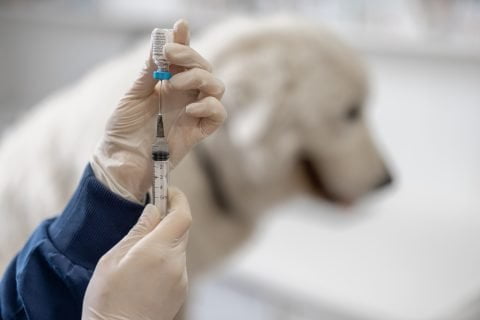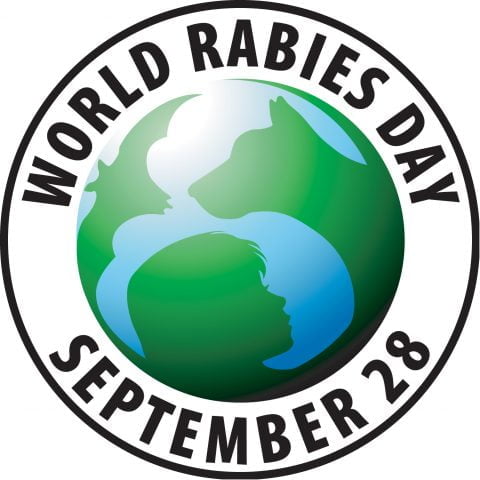Get Your Pet Vaccinated for World Rabies Day
September 28 is World Rabies Day, a global health observance started to raise awareness about rabies and bring together partners to enhance prevention and control efforts worldwide. The Humane Society of Charlotte is doing our part in preventing rabies cases in our community by encouraging dog and cat owners to have their pets vaccinated, as well as microchipped for safety purposes, at HSC's Essential Care Wellness Clinic.
What is rabies?
Rabies is a vaccine-preventable viral disease that affects the central nervous system and infects mammals, including dogs, cats, livestock, and wildlife. It can also spread to people, and other animals, through saliva (usually bites), scratches or direct contact with eyes, mouth, or open wounds.
Rabies is virtually 100% fatal once clinical symptoms appear, which is why it is so important to protect your pet family with the rabies vaccine.
Understanding the rabies vaccine
The rabies vaccination is considered a "core" vaccine and is the only companion animal vaccine that is required by law in most states.
How does the rabies vaccine work?
The rabies vaccine is a killed vaccine, meaning that the strain used in the vaccine has been inactivated and cannot cause the disease. However, because the body’s immune response to the vaccine is still antibody production, if the animal is later exposed to the virus the antibodies will quickly recognize the virus and bind to it before it can replicate enough to cause clinical signs, thus preventing fatal contraction of the disease.
How is a rabies vaccine administered?
In all states, licensed veterinarians can administer the vaccine, though in some states it can also be administered by a veterinary nurse. The vaccine can be administered in two ways depending on the species:
- Subcutaneously - into the layer of fat underneath the skin
- Intramuscularly - into the muscle
When should a rabies vaccine be administered?
While timing of the first rabies vaccination can depend on state and city guidelines, typically the rabies vaccine is first administered between 12-16 weeks old, and then repeated in 1 year. Booster vaccines are then given at either 1 year or 3 year intervals depending on the vaccine administered and local policies.
Recovering from a rabies vaccine
After the vaccine, your pet may feel a little poorly while its body works to respond to generate the antibodies but recovery is usually seen within 24-48 hours. If your pet isn’t responding well, here are some things to look out for:
- Local site reactions - redness, swelling, pain or inflammation around the injection site. These are often simply managed with rest, but in some cases your vet may prescribe pain medication to help
- Systemic reactions - facial swelling, vomiting, diarrhea, and lethargy are all signs that your pet isn’t coping well with the vaccine and needs additional treatment. In some cases, these symptoms and systemic reactions can be life-threatening so always consult your vet if you are worried something isn’t right
How much do rabies vaccines cost?
The Humane Society of Charlotte is committed to increasing access to affordable veterinary care and making these required vaccines as easy to get as possible with daily appointments. Vaccinations start as low as $10.
- $10: 1-Year Rabies Vaccine
- $25: 3-Year Rabies Vaccine (must have proof of prior rabies vaccination)
Rabies symptoms
If you know the signs of animals that may be infected with rabies, it's easier to avoid contact with them. Animals that may have an active rabies infection typically appear in 2 forms.
- Classic Encephalitic (Furious) Form: Animals may appear excessively agitated, even to the point of biting or snapping at imaginary and/or real objects. Some animals drool excessively, avoid water (hydrophobia), and at times can be seen mutilating themselves.
- Paralytic (Dumb) Form: Animals may appear uncharacteristically tame and seem to have no fear of humans. Animals may also appear excessively wobbly and exhibit circling behaviors. They may act partially paralyzed or disorientated.
- Some of these individual signs can be indicative of other diseases or poisoning, so use caution. There are few behavioral signs that are telltale of rabies alone.
Always supervise pets in wilderness areas
Spending time outdoors with your pets is excellent for their overall health, but supervising their activities, especially in wilderness areas while camping or hiking is vital to prevent accidental rabies exposure.
Vaccinated pets are extremely well protected, but it's important to follow these tips.
- Leave wildlife alone. Don't allow your pet to get too close.
- Stay on marked trails. Typically wildlife will avoid high traffic areas with humans.
- If there has been a sighting of a suspicious animal, avoid the area entirely.
- If you suspect an animal in your area could be infected with rabies, seek advice from your local animal control or state wildlife agency.

